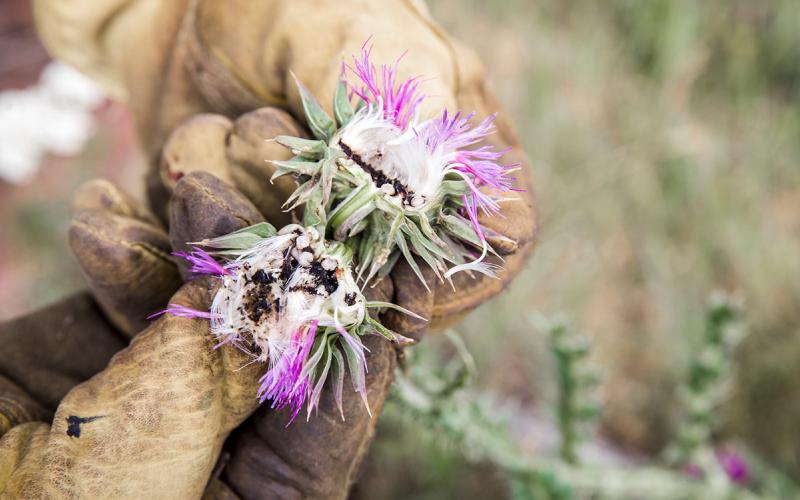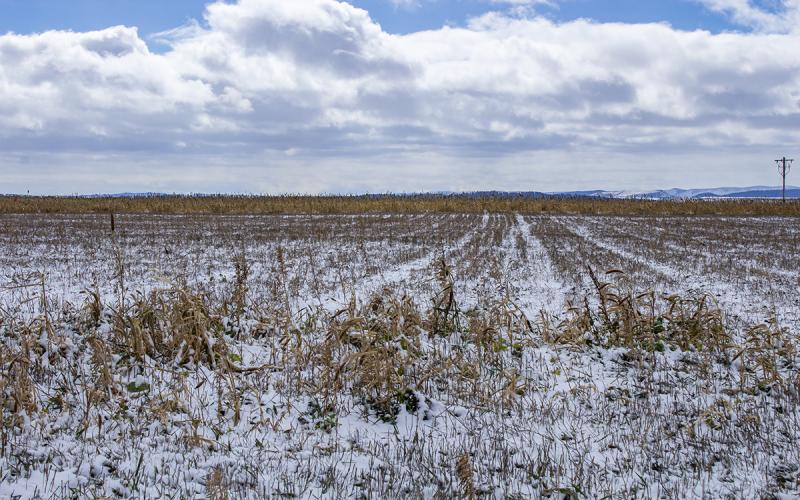Written collaboratively by Eric Jones, Philip Rozeboom, Jill Alms, and David Vos.
Most herbicide applications to manage perennial weeds have already occurred. However, now is the time to consider fall applications for weeds that were not treated or escaped the spring application. Perennial weeds, such as Canada thistle and leafy spurge, begin to transport assimilates and nutrients down to the roots/rhizomes in the fall as day length and temperatures decrease to survive the winter months. An herbicide application in the fall can be more effective by killing the underground plant material since the herbicide will translocate with the nutrients. If plants were not treated in the spring or germinated later, mowing plants now (early September) can stimulate regrowth of new vegetation that can be treated in the fall. Mowing may also need to be implemented prior to fall herbicide application to ensure the droplets land on the weeds and are not intercepted by grass or other vegetation growing nearby. Mowing large, flowering perennial plants can significantly reduce seed production. However, some perennial plants, such as Canada thistle and perennial sowthistle, should not be mowed when seeds are present, as the seeds can be dispersed across the landscape (Figure 1).

Herbicide Considerations
Effective herbicides for perennial weeds in the fall are similar to what is applied in the spring. Consult herbicide labels and the most-recent SDSU Extension Weed Control: Noxious Weeds publication for product trade names, use/use restrictions, and use rates. If areas with weeds are small and isolated, spot spraying is a viable option over broadcast spraying.
Environmental conditions can influence herbicide activity in the fall. Herbicides applied in the fall should occur around a light frost (32 degrees Fahrenheit). Killing frosts can also occur in the early fall in South Dakota and can reduce the effectiveness of a prior herbicide application. If a hard frost occurs before the herbicide, wait at least 24 hours to determine if the foliage is killed (symptoms would include necrotic [brown tissue] and wilted tissue) or survives. If the plant foliage is killed, do not apply the herbicide, as it will not be absorbed or translocated throughout the plant; if the foliage survives, herbicide can be applied if temperatures are to remain above freezing. Adequate soil moisture will likely aid in the effectiveness of the herbicide application as the plant should be actively growing. Herbicide effectiveness is decreased under drought conditions. The 2024 growing season has provided a lot of moisture for most of South Dakota, which has resulted in many perennial weeds germinating and growing rapidly. Therefore, it is likely a good idea to scout areas that were treated in the spring to determine if more management tactics need to be implemented this fall.
Other Management Tips
Similar to spring-only herbicide applications, fall-only herbicide applications may not provide effective control alone. Effective perennial weed management plans should utilize both spring and fall herbicide applications. Fall herbicide applications are also a good time to mark GPS coordinates and record notes on what other weed species are present and where the problem areas are in the landscape. Making detailed maps and notes early can improve weed control in the spring by purchasing the most-effective herbicides and applying them in the correct places. Management tactics outside of herbicides should also be utilized. Mowing and grazing can be effective when used with herbicides. Insects that feed on perennial weeds, such as the leafy spurge beetle and thistle head weevils, can also be effective in managing weeds in areas that are hard-to-access or near sensitive sites. Using all available tactics where appropriate will usually be more effective than relying solely on one tactic.


